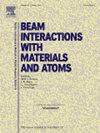用白中子场测量和计算铍样品的泄漏中子谱
IF 1.4
3区 物理与天体物理
Q3 INSTRUMENTS & INSTRUMENTATION
Nuclear Instruments & Methods in Physics Research Section B-beam Interactions With Materials and Atoms
Pub Date : 2025-08-05
DOI:10.1016/j.nimb.2025.165793
引用次数: 0
摘要
对铍材料进行了泄漏中子谱测量。采用80.5MeV/μ碳离子与natW (12C,xn)反应制备白色中子源。利用BC-501A型液体闪烁探测器,采用脉冲高度判别技术和飞行时间法测量了泄漏中子穿过7 cm厚铍板的光谱。使用GEANT4蒙特卡罗代码,使用INCL、BIC和BERT物理模型对实验进行计算分析。仿真结果与实验数据比较,结果吻合较好。本文章由计算机程序翻译,如有差异,请以英文原文为准。
Measurement and calculation of leakage neutron spectra from beryllium sample using a white neutron field
A leakage neutron spectra measurement has been conducted on beryllium material. The () reaction was employed with carbon ions to produce a white neutron source. Spectra of leakage neutrons passed through a 7 cm thick beryllium slab were measured with a BC-501A liquid scintillation detector by the pulse height discrimination technique and time-of-flight method. The computational analysis of the experiment was performed by GEANT4 Monte Carlo code with INCL, BIC, and BERT physics models. The comparisons between the simulations and the experimental data have shown reasonable agreement.
求助全文
通过发布文献求助,成功后即可免费获取论文全文。
去求助
来源期刊
CiteScore
2.80
自引率
7.70%
发文量
231
审稿时长
1.9 months
期刊介绍:
Section B of Nuclear Instruments and Methods in Physics Research covers all aspects of the interaction of energetic beams with atoms, molecules and aggregate forms of matter. This includes ion beam analysis and ion beam modification of materials as well as basic data of importance for these studies. Topics of general interest include: atomic collisions in solids, particle channelling, all aspects of collision cascades, the modification of materials by energetic beams, ion implantation, irradiation - induced changes in materials, the physics and chemistry of beam interactions and the analysis of materials by all forms of energetic radiation. Modification by ion, laser and electron beams for the study of electronic materials, metals, ceramics, insulators, polymers and other important and new materials systems are included. Related studies, such as the application of ion beam analysis to biological, archaeological and geological samples as well as applications to solve problems in planetary science are also welcome. Energetic beams of interest include atomic and molecular ions, neutrons, positrons and muons, plasmas directed at surfaces, electron and photon beams, including laser treated surfaces and studies of solids by photon radiation from rotating anodes, synchrotrons, etc. In addition, the interaction between various forms of radiation and radiation-induced deposition processes are relevant.

 求助内容:
求助内容: 应助结果提醒方式:
应助结果提醒方式:


